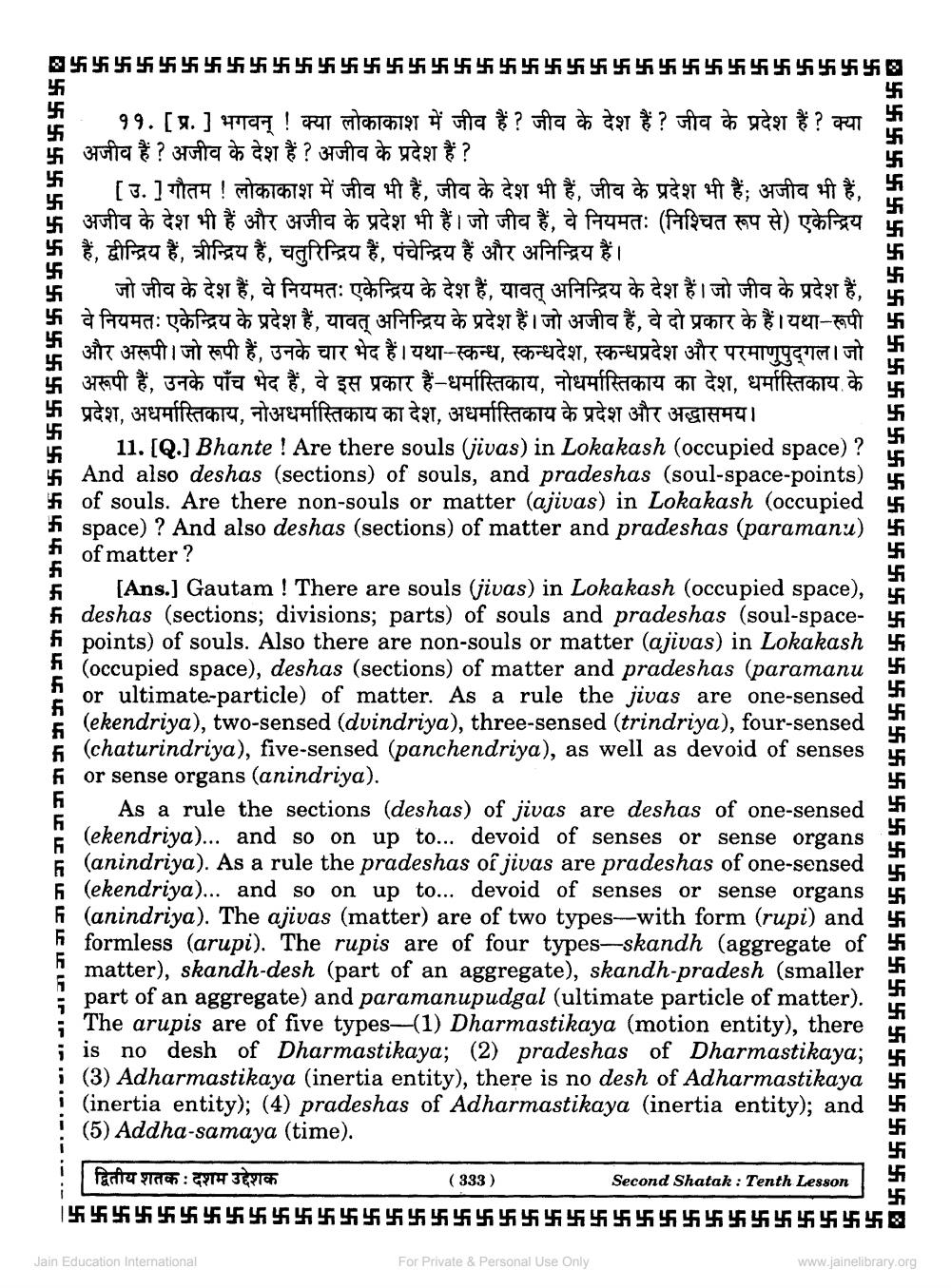________________
5 5 5 5 5 5 5 5 5 5 95 95 95 95 95 95 95 95555555555555555555
55555555555555
F
45
११. [ प्र. ] भगवन् ! क्या लोकाकाश में जीव हैं ? जीव के देश हैं ? जीव के प्रदेश हैं ? क्या अजीव हैं ? अजीव के देश हैं? अजीव के प्रदेश हैं ?
45
[उ. ] गौतम ! लोकाकाश में जीव भी हैं, जीव के देश भी हैं, जीव के प्रदेश भी हैं; अजीव भी हैं, अजीव के देश भी हैं और अजीव के प्रदेश भी हैं। जो जीव हैं, वे नियमतः (निश्चित रूप से) एकेन्द्रिय हैं, द्वीन्द्रिय हैं, त्रीन्द्रिय हैं, चतुरिन्द्रिय हैं, पंचेन्द्रिय हैं और अनिन्द्रिय हैं।
卐
जो जीव के देश हैं, वे नियमतः एकेन्द्रिय के देश हैं, यावत् अनिन्द्रिय के देश हैं। जो जीव के प्रदेश हैं, वे नियमतः एकेन्द्रिय के प्रदेश हैं, यावत् अनिन्द्रिय के प्रदेश हैं । जो अजीव हैं, वे दो प्रकार के हैं। यथा-रूपी 5 और अरूपी। जो रूपी हैं, उनके चार भेद हैं। यथा-स्कन्ध, स्कन्धदेश, स्कन्धप्रदेश और परमाणुपुद्गल । जो अरूपी हैं, उनके पाँच भेद हैं, वे इस प्रकार हैं-धर्मास्तिकाय, नोधर्मास्तिकाय का देश, धर्मास्तिकाय के प्रदेश, अधर्मास्तिकाय, नोअधर्मास्तिकाय का देश, अधर्मास्तिकाय के प्रदेश और अद्धासमय ।
11. [Q.] Bhante! Are there souls (jivas) in Lokakash (occupied space)? And also deshas (sections) of souls, and pradeshas (soul-space-points) of souls. Are there non-souls or matter (ajivas) in Lokakash (occupied space)? And also deshas (sections) of matter and pradeshas (paramanu) of matter?
[Ans.] Gautam ! There are souls (jivas) in Lokakash (occupied space), Fideshas (sections; divisions; parts) of souls and pradeshas (soul-spacefi points) of souls. Also there are non-souls or matter (ajivas) in Lokakash (occupied space), deshas (sections) of matter and pradeshas (paramanu or ultimate-particle) of matter. As a rule the jivas are one-sensed (ekendriya), two-sensed (dvindriya), three-sensed (trindriya), four-sensed (chaturindriya), five-sensed (panchendriya), as well as devoid of senses For sense organs (anindriya).
As a rule the sections (deshas) of jivas are deshas of one-sensed (ekendriya)... and so on up to... devoid of senses or sense organs (anindriya). As a rule the pradeshas of jivas are pradeshas of one-sensed (ekendriya)... and so on up to... devoid of senses or sense organs F (anindriya). The ajivas (matter) are of two types-with form (rupi) and formless (arupi). The rupis are of four types-skandh (aggregate of matter), skandh-desh (part of an aggregate), skandh-pradesh (smaller part of an aggregate) and paramanupudgal (ultimate particle of matter). The arupis are of five types-(1) Dharmastikaya (motion entity), there is no desh of Dharmastikaya; (2) pradeshas of Dharmastikaya; i (3) Adharmastikaya (inertia entity), there is no desh of Adharmastikaya (inertia entity); (4) pradeshas of Adharmastikaya (inertia entity); and (5) Addha-samaya (time).
द्वितीय शतक : दशम उद्देशक
(333)
Jain Education International
1555555555555555555555555555555555555
Second Shatak: Tenth Lesson
For Private & Personal Use Only
卐
卐
5575
卐
卐
55
455
卐
457
卐
55
45
55
475
卐
卐
47
47
卐
www.jainelibrary.org




